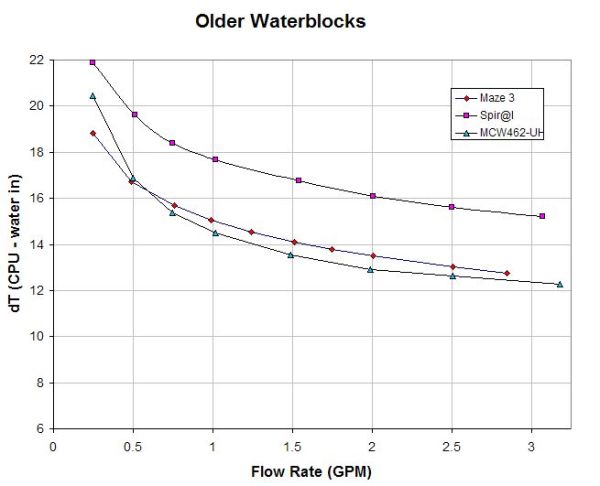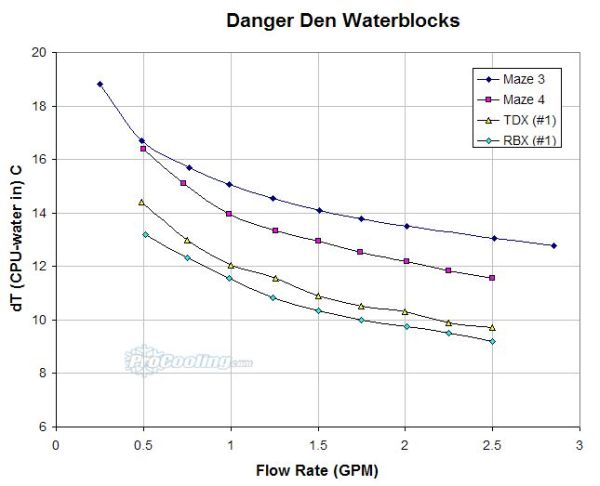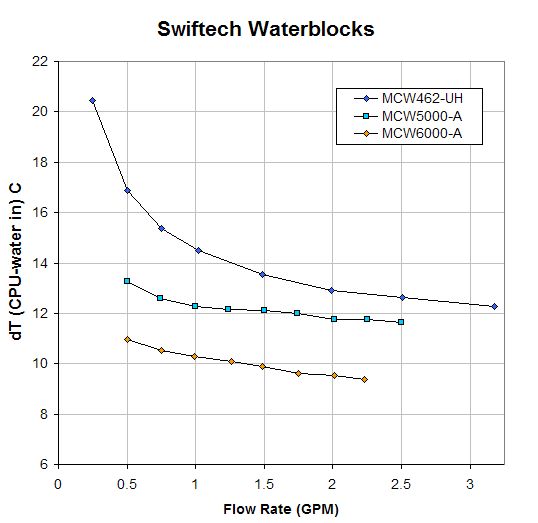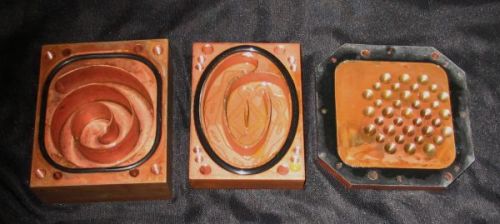|
I am more than just a waterblock tester; I'm a collector too. And with waterblocks from many different time frames sitting around collecting dust, I
decided that I'd test a few of the "vintage" waterblocks for Socket A systems. Why not, right? I thought that it'd be fun to see how much performance has improved since roughly the time I joined Procooling, and I
thought it'd be a fun way to end the Socket A . You guys can think of this as Joe's second waterblock roundup if you like, with a fairly small pool of contenders and Derek playing the role of Joe.
I don't have my old Maze 2 any more so I couldn't run my first waterblock. But I did have a Danger Den Maze 3 (copper top), a Swiftech MCW462-UH (with 1/2" barbs), and one of the original Spir@ls from fixxxitt. You guys remember these blocks? Here is a picture to refresh your memory:
 |
My Maze 3 was copper topped; the base configuration was acrylic I am pretty sure. All of these
waterblocks are "center inlet" designs, and the Maze3 and Spir@l are both fairly free-flowing spiral channels that lead to an exit. The Swiftech has an open design with a number of divots drilled into the
copper baseplate over the die area.
Compared to the blocks we use today, these blocks have much less surface area, less resistance, and rely
fairly heavily on pump power to get the job done. But how do they actually perform compared to waterblocks we use today? I figured I'd run quick tests on them and just show you guys how performance
has changed over the years. By quick tests I mean that I did one "test mount" to make sure I was making good contact between bp and CPU and then mounted the block once and ran a flow test with 30 minutes
between points. CPU speed and vcore as normal for Procooling waterblock tests (175 fsb x 12.5multi and 1.825V).
 |
I'm sure many of you remember the old handmade Spir@l waterblocks being highly sought after. It seems
pretty clear that the Spir@l was more about hype and attractiveness than it was about true performance. It's also interesting that none of these blocks have good performance at flow rates below 1GPM. These
were all introduced in the time frame when most water coolers in the US were switching to 1/2" hose and heater cores and trying to increase flow rates. Not a bad strategy I suppose given the performance curves
of these blocks....
Let's now take a look at how the results of the Swiftech and Danger Den waterblocks compare to their
newer designs, These are arguably the two most important water block manufacturers in the US, and both have been providing commercial blocks for many years. We can take a look at how their water blocks have
evolved over time and perhaps get some insight into how their design process works and where things might be heading. Let's start with Danger Den:

It's interesting to see that all the Danger Den blocks have always had more or less the same shape to their
dT vs flow curves. The Maze 4 is actually capable of higher than 2.5 GPM flow rates on my test loop; unfortunately I didn't test higher when I ran it. We can see a pretty steady improvement in performance as
Danger Den has released new waterblocks. The exception (on this graph) is the TDX, but in fact it's less restrictive than the RBX so performance is very close in real world use. Overall we can see that Danger
Den has pretty consistently been designing blocks that benefit substantially from increasing flow rates. Danger Den's choice of components for their kits makes good sense to me given the blocks' performance
curves: heatercores or other large low resistance radiators, 1/2" ID tubing, and powerful pumps. They used to sell their kits with Eheim pumps, and more recently they have brought the Laing D4 pumps to US water
coolers. The Laing D4 is a very good match for the Danger Den products shown above.
Now let's look at the Swiftech waterblocks:

What we see here is a fundamental change in design strategy from the earlier blocks (MCW462-UH) to the
newer blocks (MCW5000 and 6000). The MCW462-UH was released primarily to appease all the DIYers with 1/2" loops. It actually performs considerably worse than the 3/8" MCW462-U block Swiftech used in
their kits as demonstrated in an article for Overclockers. The MCW462 series blocks obviously relied heavily on flow rates to produce turbulence over the die area. Rather strangely, Swiftech was using Eheim
1046 pumps and 3/8" tubing when the MCW462U series was new, so they were not fully realizing the performance of this block in their kits. Unlike Danger Den, newer Swiftech blocks have decidedly different
design and performance curves. The MCW5000 and 6000 look to be geared at improved cooling performance at lower flow rates compared to the older Swiftech blocks. They have much greater surface
area (pins) and (I would guess) a somewhat thicker baseplate. These changes led to a much flatter performance curve and better performance at low flow rates for the MCW5000-A. This makes good sense
because Swiftech was bundling their MCW5000 series waterblocks with 3/8" tubing, black ice micro radiators(s), GPU blocks, and a fairly low pressure pump. By having a block with such a low flow rate
dependence, it's possible to ship it with a wide variety of configurations without losing much performance. Swiftech then brought a much higher pressure capacity pump to the community (the MCP600) and shortly
afterwards released a new waterblock designed to make good use of higher flow/pressure loops. That block is the MCW6000, their current offering. This block's performance curve does have essentially the same
shape as the MCW5000 (only shifted down considerably).
We have now seen an additional generation of new pumps (the Laing DDC) and it seems that water cooling
may be moving towards using 3/8" ID tubing again with higher pressure low flow rate pumps. What implications will this have for the next Danger Den and Swiftech blocks? I am not privy to such information
but I'm at least as interested as the rest of you guys. Anyway that's my little personal indulgence and trip down memory lane. I hope to have some new reviews of the "next big thing" whenever we see it come to pass..
|






 Old School Waterblock Tests
Old School Waterblock Tests
 from 1 Readers
Must Log In to Rank This Article
from 1 Readers
Must Log In to Rank This Article




